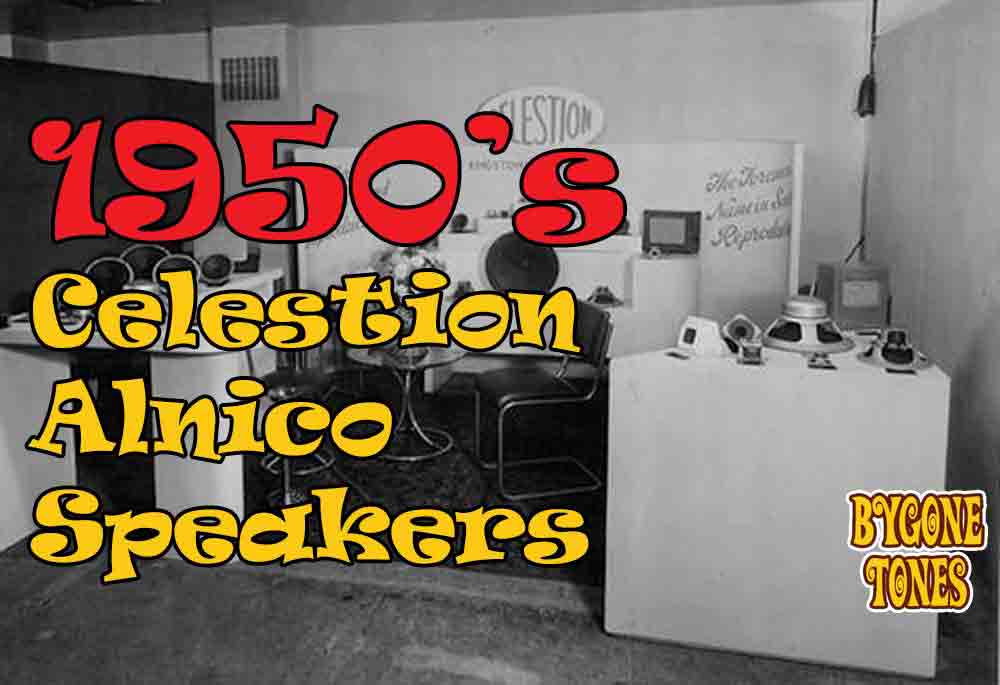
Very little seems to be known about the very early Celestion and Rola G12 speakers from the 1940’s and 1950’s such as the Rola / Celestion B025, the P74 and P44. Examples do turn up online from time to time, and I’ll share some of the information and examples that I have found here.
Every speaker is a piece of the jigsaw, so if you have any additional info or photos then please email me, I would be really interested to learn more about them.
Pre-1956 Celestion Date Codes
We already know from existing date code charts that the year code for 1956 is the letter A. I think it is safe to assume that Celestion were using the same A to M cycle before 1956. So working right back to the letter A would give us the table shown below.
| Month | Year |
|---|---|
| A = Jan | A = 1944 |
| B = Feb | B = 1945 |
| C = Mar | C = 1946 |
| D = Apr | D = 1947 |
| E = May | E = 1948 |
| F = Jun | F = 1949 |
| G= Jul | G = 1950 |
| H= Aug | H = 1951 |
| I/J = Sep | I/J = 1952 |
| K = Oct | K = 1953 |
| L = Nov | L = 1954 |
| M = Dec | M = 1955 |
For example “09EF” would be 9th May 1949.
The date codes were printed on the outer rim of the metal chassis, at least until Nov 1951 (LH date code), then on the front gasket from at least April 1952 onwards (DJ date code). I haven’t seen enough examples to narrow it down any further.
Early Brochures
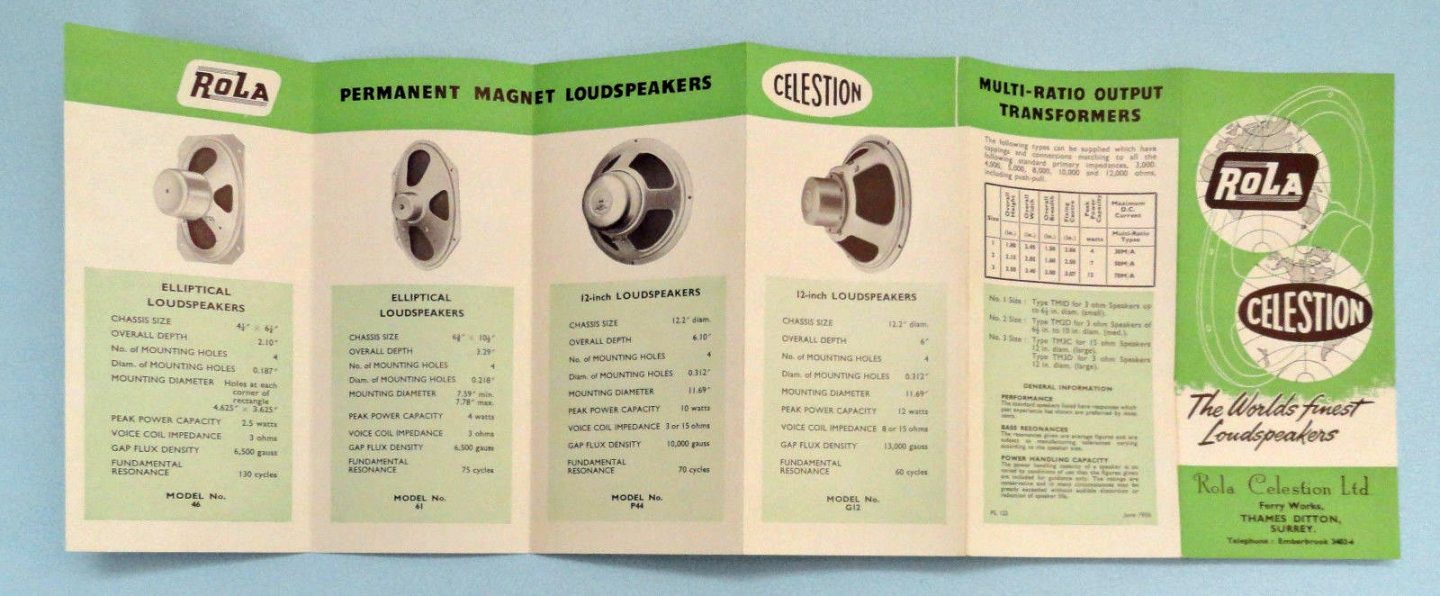
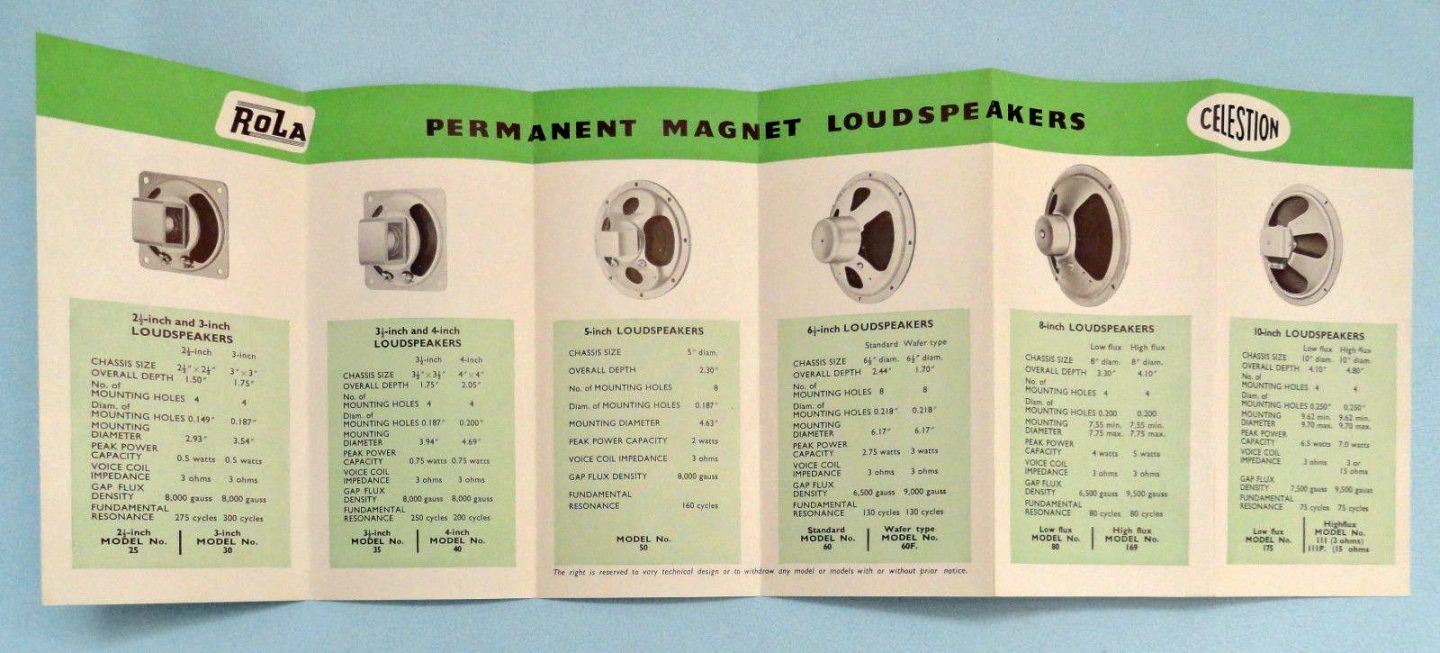
This green leaflet is dated June 1956, of interest to most guitar players will be the G12 model.
The August 1962 brochure includes the slightly more expensive ‘GL12’:
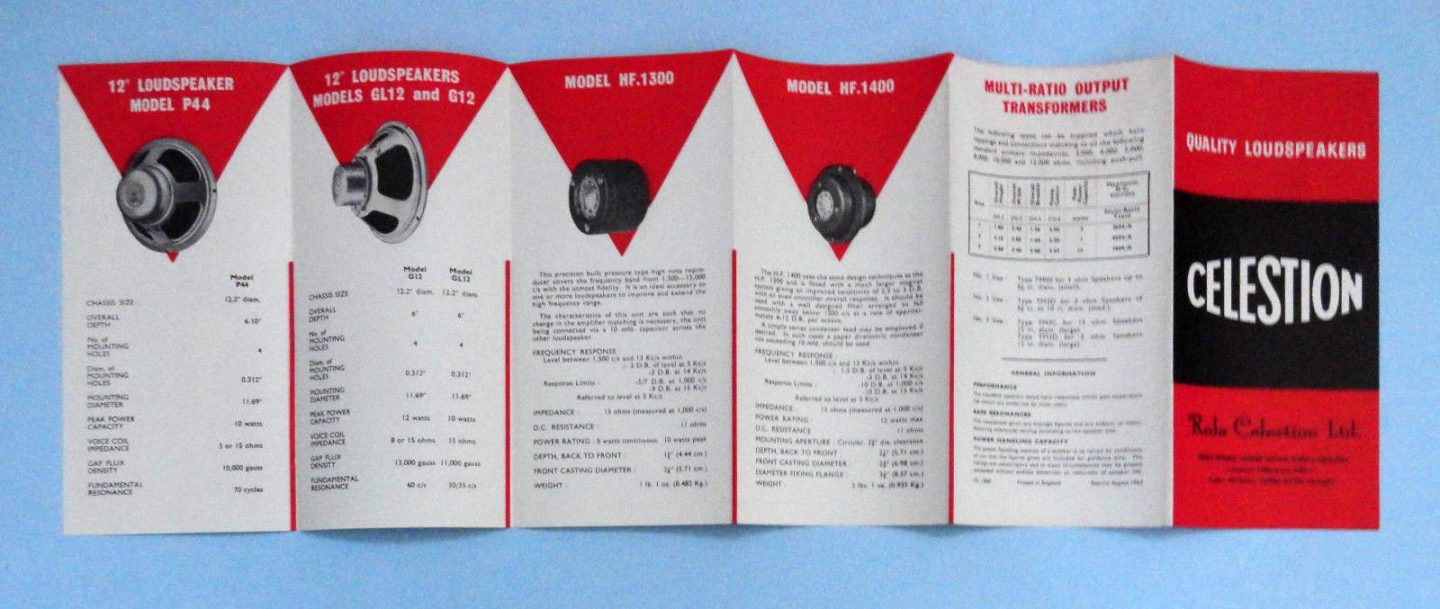
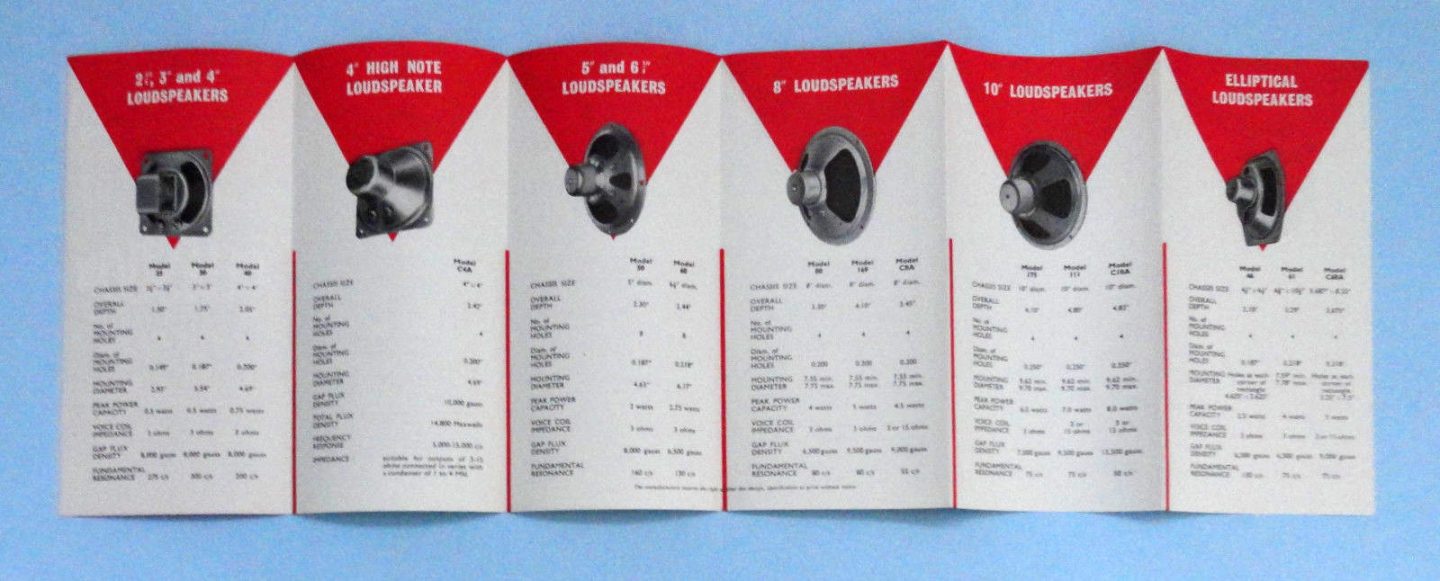
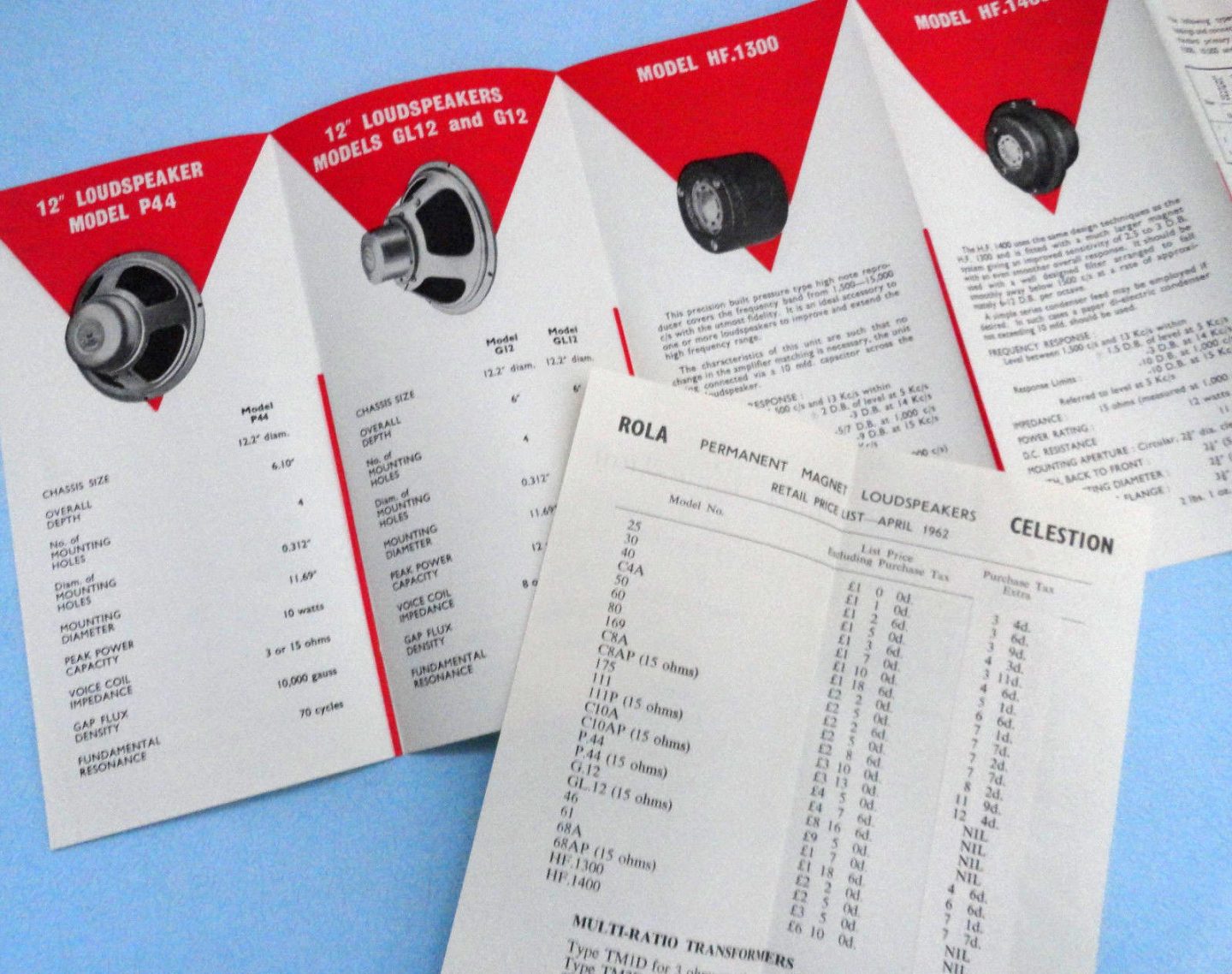
Celestion would have been making variants of the G12 mainly for Vox at this time. No greenbacks or Marshall amplifiers around yet.
Speaker Models
Rola / Celestion 1335 (3 Ohm) & 2727 (15 Ohm) – “P44”
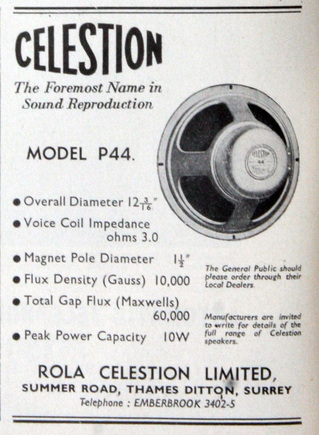
The Celestion 44 or P44 is a 10w alnico speaker with 1.5″ voice coil. Although these speakers are similar in appearance to guitar speakers I would not recommend using them for guitar, they were built for use in radiograms and other audio equipment.
Most have Celestion labels, but there are a few with Rola labels.
The Celestion brochure for the P44 describes it as “a lightweight, relatively inexpensive speaker possessing the full bodied bass response normally associated with more costly 12″ speakers, together with a particularly clean and smooth upper register. This model can advantageously replace a 10″ speaker in most radiogram applications”
1951

The 27LH date stamp on this P44 translates as 27th Nov 1951. It was sold on UK ebay with another speaker dated 19MF, which would take production of these speakers back to December 1949.
The cone stamp is usually ‘ROB’ (part of the R probably missing here), which was probably a cone made in house at the Thames Ditton factory – similar to the ‘RIC’ stamped cones. The date stamp and circular inspection stamp are printed on the rim of the metal chassis.
1965

Here we have a later P44 in excellent condition. The ’27DK’ date stamp on this speaker translates as 27th April 1965. Notice the cone is now a pulsonic with 9/830/00 stamp. The date stamp and circular inspection stamp are printed on the front gasket instead of on the metal rim.

‘Under the hood’ we can see the P44 is a very different speaker compared to your average guitar speaker.
Celestion 1478 (? Ohm)
1949

Here is a really early G12 speaker model 1478, still carrying the old motto “The Very Soul of Music”. Notice both the model number and date stamp are printed on the outer rim of the chassis. The cone stamp is barely readable.
The 25DF date stamp translates as 25th April 1949.
Celestion 1772 (15 Ohm) – “P74”
1950

The Celestion P74, model number 1772. Supposedly a higher powered version of the P44, and probably rated at 12 watts. The ribbed cone and larger magnet make these a better choice for guitar players than the P44. These seem to have the Celestion label as standard rather than the Rola label.
The MG date code printed on the outer rim could be translated as Dec 1950.
1951

No label, model number or cone stamp with this one, but has the black band around the magnet (may or may not be a 1772). The ‘GH’ date code translates as July 1951.
1954

01DL translates as 1st April 1954. RIC 1 cone stamp.
*Unknown date*

This 1772 speaker turned up on Ebay France, no date code unfortunately but notice it is labelled as a G12 rather than 74 – factory mistake or intentional? Still with the black band around the magnet.
Notice the green 1956 Celestion brochure shown above does not feature the P74 model at all. So it is possible they were discontinued by that point, and I have not seen any with later date codes.
Rola / Celestion B025 (15 Ohm) & B024 (8 Ohm)
Likely the G12 model referred to in the Celestion brochure, which states these are “12 watts peak power, 13,000 gauss magnet, with 60cs fundamental resonance”. They were designed for audio, so are not strictly speaking guitar speakers, but they were used in some early guitar amplifiers.
Shown below are a few examples that have turned up in recent years, ordered by year.
1950

This B025 model speaker turned up on UK ebay a while ago. Notice the model number (B025), date code (30CG), and circular quality control stamp are all stamped on the rim of the metal chassis. The magnet has four small nuts at the top, not the large slot head screws found on later speakers. The 30CG date stamp could translate as 30th March 1950.
1951
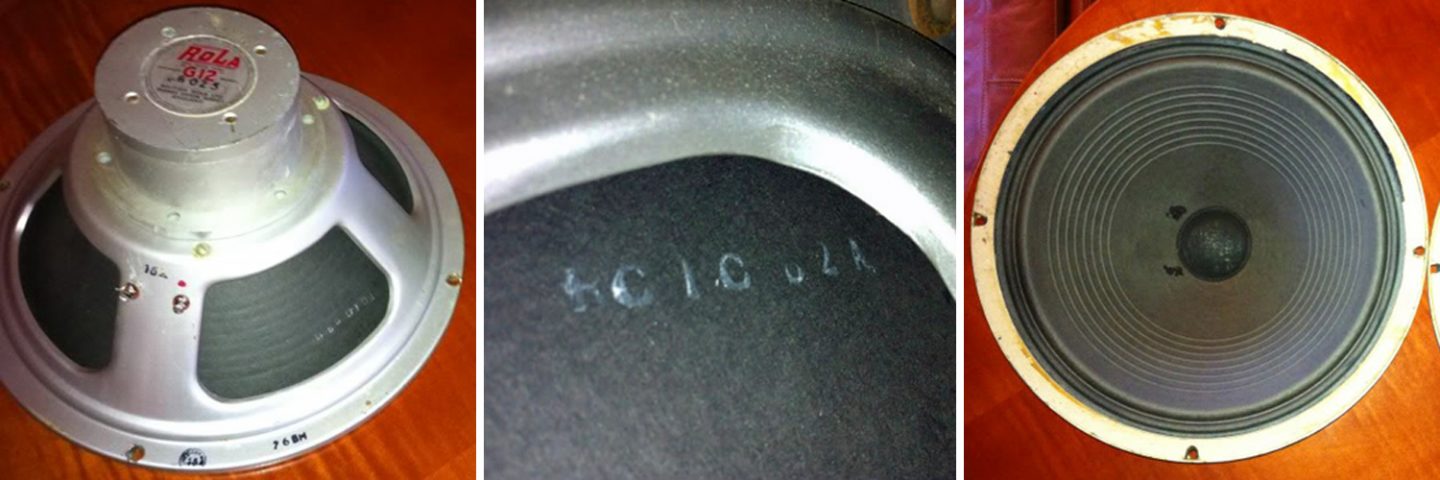
A slightly later speaker. The date stamp 26BH could indicate 26th Feb 1951. Notice the Rola label, and the additional C in the cone stamp. ‘RCIC’, instead of ‘RIC’.
The date stamp is still printed on the rim of the metal chassis.
1952

Date stamp now on the front gasket. The HJ date code could indicate August 1952. RIC cone stamp.
1954

04LL could be translated as 4th November 1954. Date stamp on the front gasket of the speaker, notice the circular quality control stamp is still on the rim of the frame. Rola label.
1955
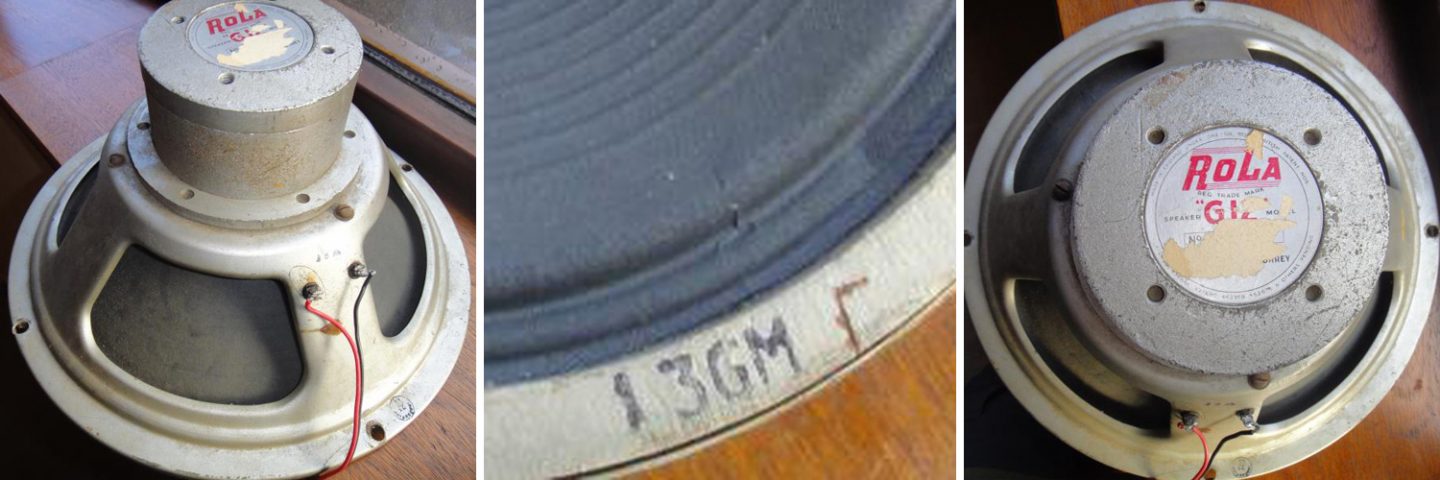
A very similar speaker to the previous one with Rola label. The date stamp 13GM could be translated as 13th July 1955. This speaker also has a RIC1 cone.
1956 (probably)

Unfortunately no visible date code on this one, but it was included with a batch of 5 others from 1956, so I believe it to be very close (one shown below). Notice the label is now Celestion B025 instead of Rola B025.
1956

06GA = 6th July 1956. Notice the magnet now has the large slot head bolts in the back.
1959
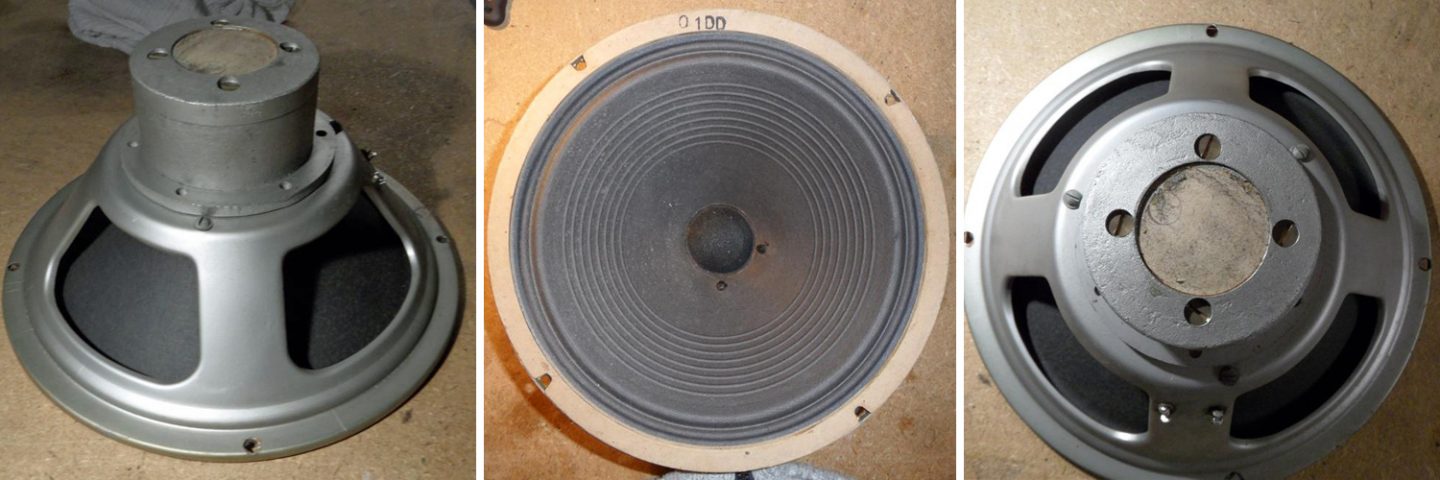
01DD translates as 1st April 1959. Unfortunately no label but assumed to be a Celestion B025.
1962
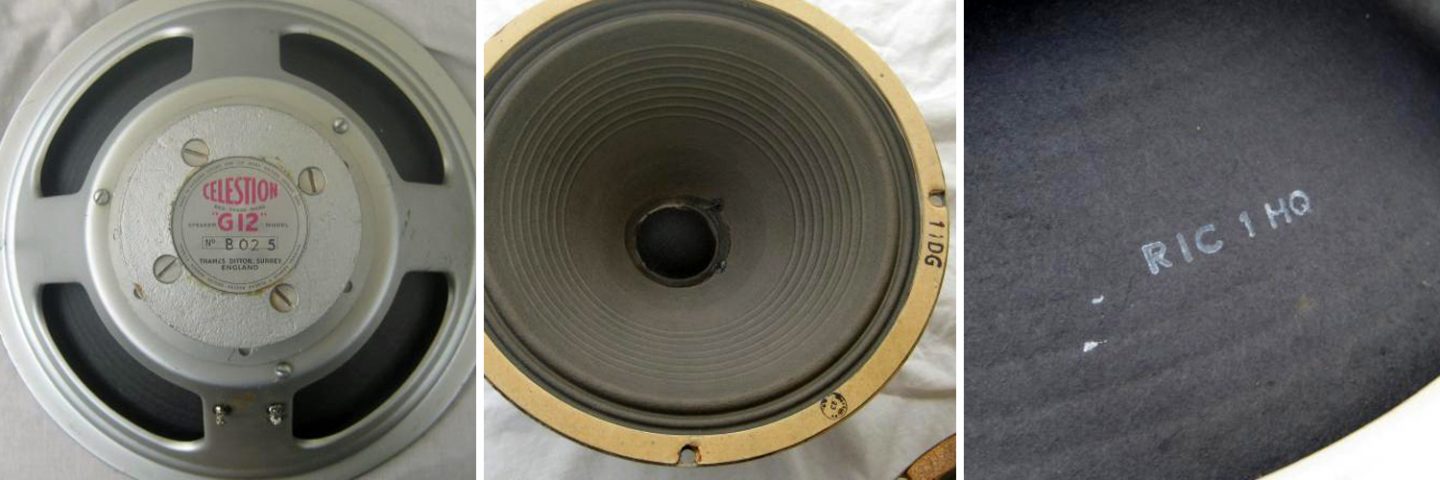
Here we have a Celestion B025 from 11th April 1962. Both the date stamp and the circular quality control stamp are on the front gasket. Large slot head bolts in the back of the magnet.
1963
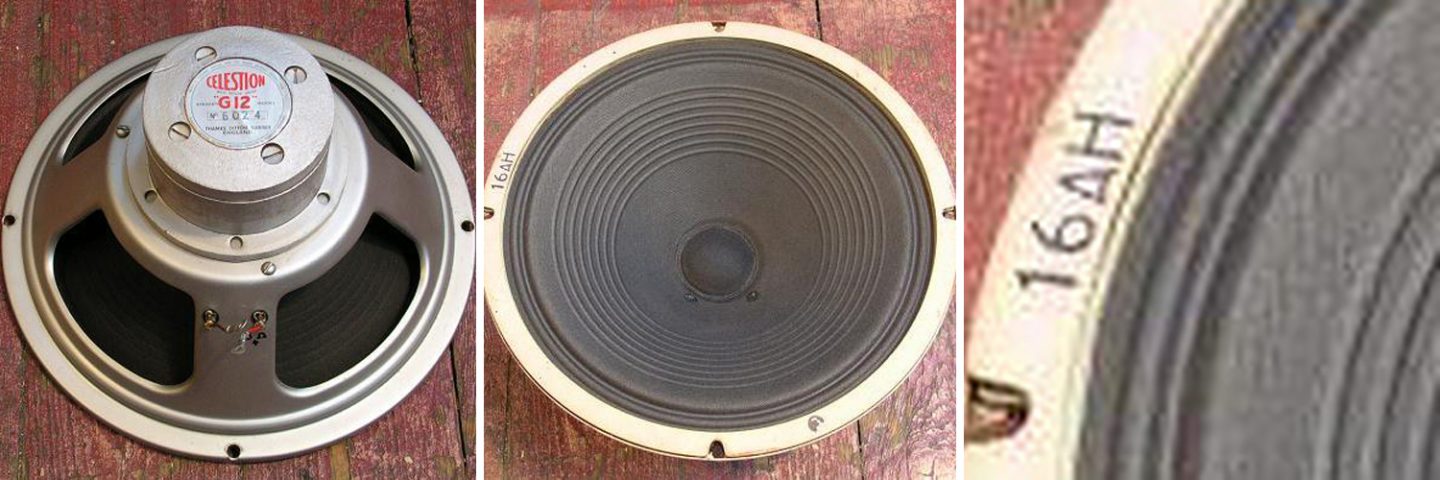
A similar Celestion B024 speaker dated Jan 1963. Celestion now using pulsonic cones. The owner of this speaker has since been in touch with me and confirmed it has the H1777 stamp.
1965

A Celestion B025 dated July 1965, also with the pulsonic H1777 stamped cone. The most recent B025 speaker I have seen and possibly one of the last ones to be made.

Hi! According to Dr. Decibel, Celestion’s in-house speaker historian, the P74 model with the M stamps are from late 1962, early 1963. Yours and mine are from December of ’62.
Author
Hi Michael, I disagree with dr.decibel on that. Can you email me some photos of your speaker showing cone stamps etc?
If the date stamp is on the outer rim instead of the front gasket then it is likely pre 1952. If it is on the front gasket, then yes 62 / 63 is a possibility.
The problem with asking Celestion / dr.decibel is that they are still using outdated and incorrect reference information, namely Michael Doyles date code chart published in 1993. Based on that they think their date stamping only began in 1956, so when you ask them, they wont consider a date any earlier.
They also think the M month codes only appeared in 1963, when Michael Doyle himself clearly stated he only found 1 speaker to base this whole theory on (see page 134 of the history of marshall book). It was a typo. I have seen several other examples of speakers with this same typo (the letter I printed instead of the letter J). There is one shown as an example on my date codes page.
With the internet we can find examples of old speakers a lot more easily than in 1993 when Michael Doyle wrote his chart. Just look on ebay at the old Celestion radio speakers, they all have date stamps on them. Where they all only made after 1956? very unlikely.
If you read through all of the info on this page you will notice a transition of the date stamp moving from rim to gasket, and different type of bolts used in the backs of the magnets, different cone stamps and labels etc. We can use these features to help us date the speaker.
Hope that helps,
Brian
I have two B025s from 1966 according to the date code on them. They came inside a Vox AC30 but I don’t think they’re original. I think I remember the chap I bought the amp off saying they’d come from a Marshall amp.
Author
Hi Gary, sounds interesting, can you email me some photos please? info@bygonetones.com They are unlikely to be out of a Marshall, but I think Vox did use them early on.
Brian.
i have one of these speakers that came in a 1961 ac30 and one blue..both have the 003 on the cone..it has a code on the rim 57 GK OR GM hard to tell
Author
Hi Richie, sounds interesting. Can you email me some photos? info@bygonetones.com
thanks, Brian.
brian sorry for been 2yrs late..i will post the pics of the speakers to you in the next few days
I bought a model 44 10 watt speaker for my guitar amp, did I make a mistake?
Author
Hi, always worth experimenting and see how it sounds. Let me know what you think of it. I have not actually tried one myself. They are only rated at 10w in the old catalogues though, and were not really designed for use with guitar. Personally I would only use a 5w amp with that, and hope all previous owners have done the same and not blown the speaker! regards, Brian.
Hi, I have an early Rola labelled P44 Alnico speaker dated 2nd January 1950. It works fine as a guitar speaker with a 5 watt valve guitar amp and really sings when used with slide guitar. Just don’t push it too far, it’s only rated for 10 Watts. Mike.
Author
Hi Mike, thanks for the info. How do you find the tone? Lacking in bass I’ve heard. I’ll have to try and get hold of one at some point and give it a whirl.
Brian.
Yes Brian, it’s a bit light on bass, definitely not a hard rocker but nicely detailed and dynamic, good for blues and slide. Mike.